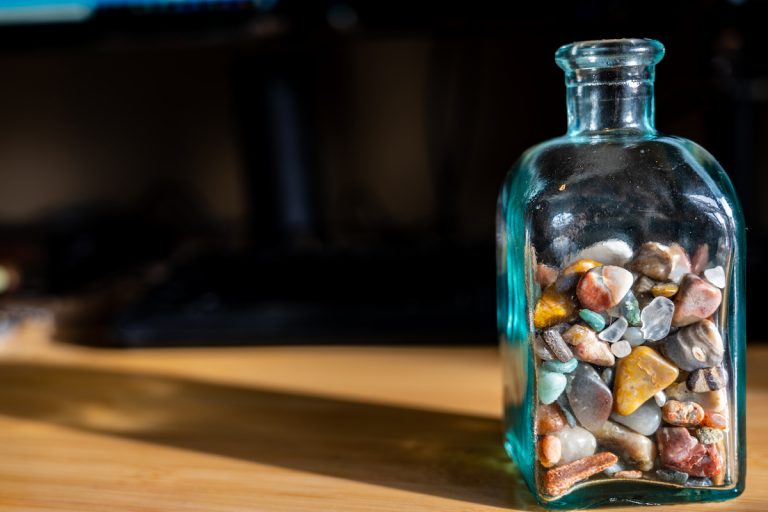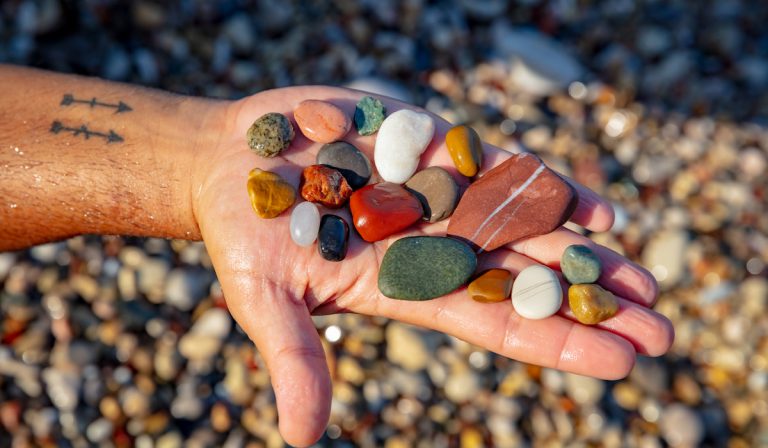Can You Put Polished Rock in a Fish Tank? (Dos and Don’ts)
Polished rocks are beautiful. They are round, smooth, and shiny. If you have polished rocks, you will want to showcase them for everyone to see.
One popular place people showcase their rocks is in a fish tank. But is it safe to put your polished rocks in there?
As long as your polished rocks are not coated with toxic finishing products, you can put them in fish tanks. Plain polished rocks are just tumbled rocks, so they are safe to be used in aquariums.
What type of finishing products are toxic to aquarium fish? How can you prepare polished rocks to be used in aquariums? We’ll answer these questions and more throughout this article.

What Exactly Are Polished Rocks?
Polished rocks are smooth, rounded tumbled rocks. When rough rocks are tumbled, they become really smooth and beautiful.
Tumbling rocks to a polished state does not make them toxic in any way. Rocks only become unfit to be used in aquariums if they are coated with toxic products.
Avoid Rocks Coated with Lacquer and Other Harmful Products
Lacquer is a finishing product used to coat wood, metal, and other items to prevent them from rusting or decaying quickly. In rock art, lacquer can be used to retain the natural (or painted) colors of stones.
While many rock enthusiasts use lacquer to coat their rocks, it can make rocks toxic in aquariums when it dissolves into the water and harms your fish.
Aside from lacquer, other products that you should not coat your rocks with (if you want to put the rocks in aquariums) are clear nail polish, transparent acrylic, car wax, and petroleum jelly.
You can test to see if rocks are coated even if the products are clear. Simply scrape the rocks with other rocks or nails. If you see white flaky materials scraping off the rocks, the rocks are coated.
You should either use coated rocks for other purposes or scrape them completely before using them in aquariums.

Make Sure the Polished Rocks Are Safe By Asking the Seller
The best way to tell whether a polished rock is coated or generally safe to be used in aquariums is by asking the seller. Rock collectors and shops are ready to tell you if the polished rocks you are buying are safe for aquariums or not.
They will tell you if the rocks are coated or not and will give you the assurance that their polished rocks are safe for aquariums.
If you collected and tumbled the rocks yourself, you’ll know that the rocks are safe to be put in aquariums. Note that not every type of rock is safe for aquariums. We will discuss safe and unsafe rocks for aquariums later.
If you are sure that your polished rocks are safe to be used in aquariums, you will need to prepare them properly to go in your aquarium.
How to Prepare Polished Rocks for Aquariums
Follow the steps below the prepare your polished rocks for your aquarium.
1. Wash and Dry the Polished Rocks

Rocks can carry algae, bacteria, fungi, and other microbes or parasites into your fish tanks. Thoroughly washing your polished rocks in soapy water can remove a lot of the microbes.
After washing each rock, you should wait until they are dry before moving to the next step.
2. Bleach and Rinse the Rocks
Bleaching your polished rocks can kill more than 90% of the remaining microbes and parasites. To bleach your polished rocks, soak them in a bleach solution. You can make a bleach solution by mixing one-part bleach (any reputable brand of your choice) with eight- or nine-parts water.
Soak the polished rocks in the bleach solution for more than 30 minutes.
After 30 minutes, carefully rinse every rock to remove the bleaching agent. You can even give the rocks a minor scrub.
3. Boiling and Cooling
It is important that you boil rocks (whether polished or not) before putting them in aquariums as boiling rocks can prevent the last trace of algae from entering your fish tank through the rocks. Boiling rocks can also rinse the bleach off the rocks.
Place the rocks in boiling water for 20-30 minutes and then remove them to cool. You can cool them in the boiled water for the next step.
4. Test the Rocks (To Make Sure)

It is time to test your polished rocks to see if they will introduce algae into the aquarium or not. Keep the rocks in sterilized (previously boiled) water for 4-5 days. If you see traces of algae or the water becomes green in this period, it means that the rocks still have algae on them.
Repeat the cleaning process from step one. If no trace of algae, you can move on to the final step.
You can also test your polished rocks to see if they are safe for your aquarium fish. Keep some of the polished rocks in a little container with one or two fish for 12-24 hours. If the fishes are actively swimming (or no sign of illness) after this period, the rocks are safe to be put in the aquarium.
5. Place the Polished Rocks in the Aquarium
Now you are ready to put the polished rocks into your aquarium. Drain off 70-80% of the water from the fish tank. If you have a lot of fish in the tank, you should keep them in a separate tank when placing the rocks.
Arrange your rocks in the tank according to their colors and sizes. Small rocks should be closer to the front of the aquarium and brighter rocks should be above dark or brown rocks. Arrange the rocks the way you want, but make sure that they make your aquarium beautiful.
Do not throw rocks into the aquarium or you could damage the glass.
When you are done arranging the rocks, you should fill the tank with water and introduce the fish back into the tank.
Related Questions and Answers
1. What Types of Rocks Should You Use or Avoid Using in Aquariums?

Not every stone can go into the aquarium (polished or not). Some rocks affect the quality of your aquarium water while others can harm your aquarium fish. Here are some safe rocks for your aquarium:
- Crystalline quartz (amethyst, rock crystal, citrine, smokey quartz, and rose quartz).
- Granite
- Microcrystalline Quartz (agate, sard, and jasper)
- Jade (Can be very expensive).
- Petrified wood
- Onyx black rock
- Slate
Here are some rocks that you should not put into your aquarium:
- Coal
- Dolomite
- Limestone (affects water pH)
- Sandstone
- Fool’s gold (Pyrite)
- Emerald
- Moonstone
- Lava rock
Instead of using the stones listed above as aquarium stones, you should display them in other ways in your home.
2. What Do Bad Rocks Do to Your Aquarium?

Some reasons why you should not use bad stones in aquariums are:
- They Alter Water pH: Stones such as limestone can significantly increase the pH of your aquarium and kill your fish who are used to a neutral or slightly acidic water conditions.
- They Add Sulphur and Other Harmful Elements: Rocks such as lava rocks have a lot of toxic elements and can harm your aquarium fish.
- They Crumble Quickly: Sandstones and other soft rocks can quickly crumble. These stones will make you clean your aquarium more often than needed.
Do not put unsafe rocks in your aquarium.
3. How Do You Clean Polished Rocks in Aquariums?
Cleaning polished rocks in aquariums is similar to placing the rocks in the aquarium. In time, there might be a buildup of fish waste or even the growth of algae in your fish tank and you have to do a routine cleanup of the tank.
To clean the polished rocks, drain water off the tank and remove the fish. Collect the rocks and clean them by scrubbing and boiling them.
If you want, you can soak them in a bleach solution before boiling. Place them back into the tank afterward.
4. What Can You Do with Rocks That You Cannot Use in Aquariums?

If a rock is unsafe for aquariums, here are some other uses for it:
- Rock Display: You can display the rocks in your rock collection case. Label them if you want.
- Rock Art: You can either coat the rocks to retain their color or you can draw patterns on them to make them more beautiful.
- Landscaping: Many types of rocks are suitable for landscaping. You can even use them as mulch.
There are many uses for rocks. You don’t have to only put them in aquariums.
5. Which is Better: Boiling or Bleaching Polished Rocks?
Boiling and bleaching rocks are both techniques people use to sterilize their rocks or kill every microbe on the rocks. Some people only boil the rocks while others are comfortable with bleaching alone.
Boiling rocks for an extended period is more effective than bleaching rocks. This is because bleaching solutions might not kill 100% of microbes on the rocks.
Final Thoughts
You can put polished rocks in a fish tank as long as the rocks are only polished (from tumbling or natural weathering) and not coated with toxic materials such as lacquer.
Plain polished rocks can make your aquarium beautiful.
Before adding them to the aquarium, make sure that you prepare them by washing, bleaching, and boiling them to prevent any harm to your aquarium fish.
Resources
- https://foxandtoad.com/blogs/blog/can-you-put-polished-stones-in-an-aquarium
- https://www.myaquariumclub.com/safe-and-unsafe-aquarium-rocks-533.html
- https://healingpicks.com/can-you-put-crystals-in-a-fish-tank/
- https://aquariumtidings.com/adding-rocks-to-aquarium/
- https://www.monsterfishkeepers.com/forums/threads/polished-stones.87744/







